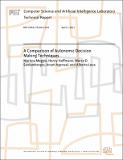| dc.description.abstract | Autonomic computing systems are capable of adapting their behavior and resources thousands of times a second to automatically decide the best way to accomplish a given goal despite changing environmental conditions and demands. Different decision mechanisms are considered in the literature, but in the vast majority of the cases a single technique is applied to a given instance of the problem. This paper proposes a comparison of some state of the art approaches for decision making, applied to a self-optimizing autonomic system that allocates resources to a software application, which provides direct performance feedback at runtime. The Application Heartbeats framework is used to provide the sensor data (feedback), and a variety of decision mechanisms, from heuristics to control-theory and machine learning, are investigated. The results obtained with these solutions are compared by means of case studies using standard benchmarks. | en_US |
